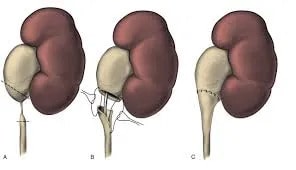Pyeloplasty
What is a Pyeloplasty?
Pyeloplasty is a surgical procedure to remove the area of blockage at the pelvic ureteric junction (PUJ).

PUJ Obstruction (Pelvic Ureteric Obstruction)
Why is a Pyeloplasty Performed
The kidneys filter the blood to produce urine, which passes through the renal pelvis, a funnel shaped area on each kidney, to tubes called ureters that lead to the bladder.
A blockage can sometimes occur at the junction of the renal pelvis and the ureter called the pelvic ureteric junction (PUJ), causing urine to accumulate and damage the kidney.
This condition can occur due to an abnormally developed PUJ, the presence of kidney stones, scar formation, infection, back flow of urine (vesico-ureteral reflux) or a vessel that compresses the area (known as crossing vessel).
Types of Pyeloplasty
Dismembered Pyeloplasty
Dismembered pyeloplasty is usually the technique of choice for most pelvic ureteric junction (PUJ).
- It involves dismembering or separating the ureter along with part of the renal pelvis and re-joining it to a more favourable area after dissecting any excessive renal pelvis tissue and widening the upper end of the ureter.
- If a crossing vessel is the source of obstruction, the pelvic ureteric junction is moved in front of it. Any stones present are destroyed or removed.
A Pyeloplasty is traditionally performed through open surgery, but Dr Kim offers a minimally invasive approach (laparoscopic or robot-assisted) that allows enhanced cosmesis and recovery.

Pyeloplasty
Open Surgery
A large incision is made on the side with the PUJ obstruction. The skin and deep layers including muscles are pulled aside so the area of PUJ obstruction can be directly seen and repaired successfully.
Laparoscopic Surgery
Several small cuts (5-8 mm wide) are made in the belly. Dr Kim operates long, thin “sticks” with tools inside the tiny holes from the outside of the belly, while his assistant holds a camera to enable key hole repair.
Robotic Surgery
Several small cuts (8 mm wide) are made in the belly. Dr Kim uses a robotic console to control the robotic arms, which move small tools underneath the skin to do the operation. Robotic technology offers superior precision and enables surgeon to perform a complex reconstruction.
Benefits of Robotic Pyeloplasty
Robotic-assisted pyeloplasty benefits include
- its precision,
- shorter operating time and hospital stay,
- smaller incisions with minimal scar formation, and
- a faster recovery and early return to your daily activities.
How is Robotic Pyeloplasty Performed
During the procedure, you will lie on your side.
- Three to four small skin incisions are made on the side of the affected kidney.
- A laparoscope (long lighted fibre-optic tube with a camera) and surgical instruments held by robotic arms are inserted.
- A 3D imaging system provides an enlarged and clear vision of the operating site on a monitor.
- The arms of the robot are controlled by Dr Kim who sits remote from you, at a console.
- Movements made by Dr Kim are translated into movements by the robotic arms as the surgery is performed. This improves manoeuvrability and precision.
As with any surgery, robotic pyeloplasty may be associated with complications such as bleeding and infection.
